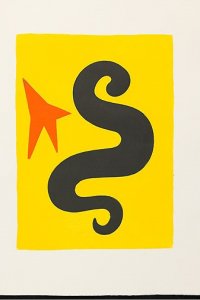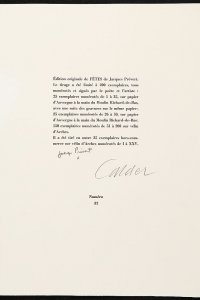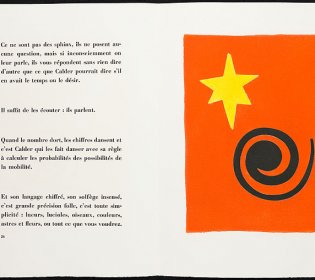Fêtes
Year: 1971
Author: Jacques Prévert (1900 - 1977)
Artist: Alexander Calder (1898 - 1976)
Publisher: Maeght éditeur
Embossed surfaces
The shapes on the flat surface have also been purged of all unnecessary decorations, but in this case movementis not created by draught or breeze. In spite of the paper's two-dimensionality, the embossed illustrations in Fêtes show depth. The saturated colours yellow, blue, red and green make them lively and suggest movement. Calder's work is therefore often called 'kinetic'. The work may be compared to that of Joan Miró: it creates a similarly festive impression. This typifies the artist who once said that art should be 'cheerful' rather than 'sinister'.
Calder and the art of the book
Calder was trained as an engineer, then went to night school at the Art Student's League in New York, worked as an industrial draughtsman, and after meeting Mondriaan in 1930, dedicated himself to the production of mobiles. These included large-scale standing and hanging works of art for public space ('mobiles' and 'stabiles', thus described by Duchamp and Hans Arp). Calder also designed stage sets, carpets and jewellery—mostly necklaces—and illustrated a number of children's books and books published in limited editions between 1941 and 1955. The line drawings in these editions are related to the etchings he made in 1967 for the book La proue de la table, with text by Yves Elléouët, and in 1974 for Santa Claus, with text by e.e. cummings. Although he worked in all areas of the graphic arts (from etchings to wood engravings) and was frequently asked to illustrate the covers of magazines and catalogues later in life, he was only sporadically involved with the specific art of the book.
Festivity
In the early 1940s, Calder produced a series of gouaches with circles and colourful organic forms set against a white or red background. His paintings on linen or plywood also compare to the engravings he made for the unusual book Fêtes in 1971. The copy in the Koopman Collection consists of separate quires inside a cover, the whole of which is held together by a linen slipcase; its size is nearly 50by 35 centimetres. The text for the book was written by the popular poet Jacques Prévert (some of his poems wereset to music). It is a long homage to Calder in the form of a prose poem. He describes the artist as a warm personality with the energy, the pleasure and the playfulness of a dolphin. His signs in Fêtes speak: 'Il suffit de les écouter: ils parlent', he says. (Listening suffices: they talk).
Calder produced seven embossed etchings. The comparison with his gouaches was a natural one, as Calder had first made precise colour drawings for these etchings. He then cut out the shapes he had drawn in a sheet of metal. These shapes were laid out in the open press, exactly like the design in the original drawing. The colours, which had been defined in advance, were brushed on, the paper was laid on top, and the whole arrangement was moved through the press. The small metal shapes created subtly embossed forms in the paper. This personal etching technique, which is typically that of a sculptor, is entirely directed towards acquiring depth and a three-dimensional effect. With its brilliant colours and Prévert's praise, Fêtes became a doubly festive book.
Bibliographical description
Description: Fêtes / Alexander Calder [eaux-fortes] ; Jacques Prévert [texte]. - Paris : Maeght éditeur, 1971. - 39 p. : ill. ; 49 cm
Printer: Fequet et Baudier (text), Adrien Maeght (Paris) (etchings)
Edition: 225 copies
This copy: Number 87 of 175 on vélin d'Arches
Typeface: Bodoni
Note: Signed by the author and the artist
Bibliography: Bénézit 3-117 ; Johnson 152 ; Monod 9290 ; Prout II-71-05
Shelfmark: KW Koopm E 70
References
- Maurice Besset (Red.), Alexander Calder. Zürich, Kunsthaus, 1975
- Calder: Gravity and grace. London, Phaidon, 2004.
- Paul van Capelleveen, Sophie Ham, Jordy Joubij, Voices and visions. The Koopman Collection and the Art of the French Book. The Hague, Koninklijke Bibliotheek, National Library of the Netherlands; Zwolle, Waanders, 2009
- Paul van Capelleveen, Sophie Ham, Jordy Joubij, Voix et visions. La Collection Koopman et l'Art du Livre français. La Haye, Koninklijke Bibliotheek, Bibliothèque nationale des Pays-Bas; Zwolle, Waanders, 2009
- De l'écriture à la peinture. Saint-Paul, Fondation Maeght, 2004
- Jean Lipman, Calder's universe. New York, The Viking Press, 1976
- Marla Prather, Alexander S.C. Rower, Arnauld Pierre, Alexander Calder 1898-1976. Washington, National Gallery of Art; New Haven, Yale University Press, 1998




